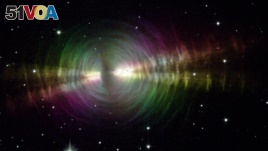19 January 2020
Scientists say they have identified the oldest solid material on Earth – stardust believed to have formed about 7 billion years ago. It was found in pieces of meteorite that fell out of the sky in Australia 50 years ago.
Stardust is matter that forms as small particles in space when stars die. These particles can be used later to form new planetary bodies, including stars, planets and moons.
The meteorite pieces came down in September 1969 in the town of Murchison, in Australia's Victoria state. Scientists with the Field Museum of Natural History in the American city of Chicago have long held the largest collection of these pieces.
But until now, the age of the oldest stardust samples had not been confirmed.

This image taken by the Advanced Camera for Surveys on the Hubble Space Telescope shows thick space dust produced by stars around the preplanetary Egg Nebula. (Image credit: NASA, W. Sparks - STScI - and R. Sahai - JPL)
Researchers at the museum reported their identification last week in Proceedings of the National Academy of Sciences.
"This is one of the most exciting studies I've worked on," said Philipp Heck, a curator at The Field Museum who led the research. "These are the oldest solid materials ever found, and they tell us about how stars formed in our galaxy," he added.
The scientists said the microscopic particles were made of silicon carbide, the first mineral formed when a star cools. All of the samples predate the formation of our own solar system, they noted.
The researchers said the stardust particles "became trapped in meteorites, where they remained unchanged for billions of years." This makes the samples "time capsules" of events that happened before the solar system.
The identification process first involved crushing the samples down into a fine dust. The pieces were then mixed with acid, which left only the pre-solar particles.
The researchers then examined samples for information that would help them identify what kinds of stars they came from and how old they were.
In space, dust interacts with cosmic rays -- high-energy particles that move through space at nearly the speed of light.
Philipp Heck explained that some of these interactions result in the formation of new elements. The longer the interactions last, the more elements are formed. Age can then be estimated by measuring how many of the new cosmic ray-produced elements were present in pre-solar samples, Heck said.
Based on examinations of this data, the researchers learned that some of the pre-solar particles were the oldest ever discovered. The team identified the age of 40 grains, most of which were estimated to be between 4.6 billion and 4.9 billion years old.
These ages relate to the time when the first stars began to break up. Since that kind of star lived for up to 2.5 billion years, the stardust can be as old as up to seven billion years.
The latest dating process confirms a scientific theory that predicted "a baby boom of stars" happened before the formation of our sun.
"We have more young grains than we expected," Heck said. He added: "We basically came to the conclusion that there must have been a time in our galaxy when more stars formed than normal, and at the end of their lives they become dust producing."
I'm Bryan Lynn.
Bryan Lynn wrote this story for VOA Learning English, based on reports from Reuters, Agence France-Presse, Proceedings of the National Academy of Sciences and The Field Museum of Natural History. Ashley Thompson was the editor.
We want to hear from you. Write to us in the Comments section, and visit 51VOA.COM.
________________________________________________________________
Words in This Story
meteorite – n. a piece of rock from outer space
sample – n. a small amount of something that represents what it is like
curator – n. a person who is in charge of a museum
time capsule – n. a container filled with objects considered to be typical of a period in history and buried, so that it can be dug up and studied much later
interact – v. to act upon one another
baby boom – n. a large increase in the number of babies born in a particular place during a particular time
grain – n. a very small piece of a hard substance
conclusion – n. a decision made after a lot of consideration